- Coat of arms of the Prince of Asturias
-
Coat of arms of the Prince of Asturias 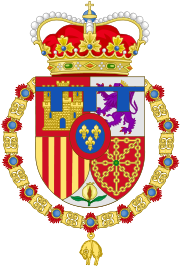
Details Armiger Felipe, Prince of Asturias Adopted March 16, 2001 Crest The Crown of the Prince of Asturias Escutcheon Quarterly: Castile, León, Aragon, and Navarre; enté en point: Granada; inescutcheon Bourbon (Anjou Branch); the whole differenced by a label azure. Orders Order of the Golden Fleece Earlier versions see below The blazon of the coat of arms of the Prince of Asturias appears in Royal Decree 284 of 16 March 2001, whereby His Guidon and His Standard are created.
QUARTERED SHIELD:
- 3rd, Or four pallets Gules, which is for Aragon;
- 4th, Gules a cross, saltire and orle of chains all linked Or, an emerald Proper, which is for Navarre; Argent enté en point, with a pomegranate Proper seeded Gules, supported, sculpted and leafed in two leaves Vert, which is for Granada. Inescutcheon Azure with three fleurs-de-lys Or, bordure Gules, which is Bourbon. The whole differenced by a label of three points Azure, the difference used by the Heirs apparent of the Spanish House of Habsburg.
The shield, crested with a closed crown, which is a circle of gold, with an inset of precious stones in their colours, composed of eight rosettes of acanthus leaves, of which five are visible, interspersed with pearls in their own colour, issuing from which are four pearl diadems, of which three are visible, which converge in a blue orb, with gold semi-meridian and equator, surmounted by a gold cross, the crown lined with red and surrounded by the collar of the Golden Fleece.
History
- For the changes of the heraldic charges and the divisions of the field, see Coat of arms of Spain.
Historical Arms of the Prince of Asturias Arms Dates Details 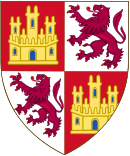

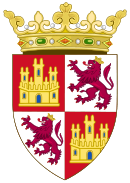
1388–1504 The arms used in the 13th and 14th century by the Prince of Asturias, and the others heirs apparent to the Castilian Throne before the title was adopted, were the undifferenced Royal Arms. However, the Infantes used differenced arms.[1][2] 1506–1516 When the House of Habsburg inherited the Crowns of Castile and Aragon marks of Cadency - a label of three points - were added to the heirs apparent's arms, as was usual in the heraldry of many European monarchies. Prince Charles (Charles I as King of Spain and Charles V as Holy Roman Emperor) used his father's arms - A quartered shield, depicting Austria, new Burgundy, old Burgundy, Brabant and Flanders on an escutcheon - with a label argent. These arms weren’t used as Prince of Asturias because Prince Charles didn’t add the arms of Castile and Aragon.[1][2][3] 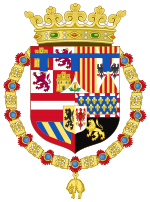
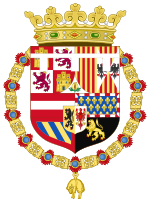
1528–1556 Prince Philip (Philip II as King of Spain and Philip I of Portugal) used his father's arms differenced with a label argent or azure. The Prince Philip's arms are showed on many Prince's armours. Now these armours have been kept at the Royal Armoury in the Royal Palace of Madrid. Sometimes, Philip also used the undifferenced arms of his father.[1][2][3] 

1560–1568 In 1568 Prince Carlos, the eldest son of Philip II, died and an Ambrosio Morales's report for the Prince's sepulchre said his arms were the Royal Arms but with "a label azure with its three short points". Prince Carlos also used the royal arms differenced with a label argent.[1][2][3] 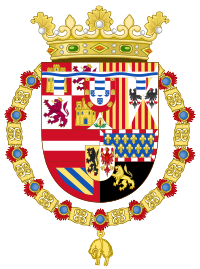
1584–1598 Prince Philip (Philip III as King of Spain and Philip II of Portugal) sometimes used a new label argent variant wavy azure.[2] 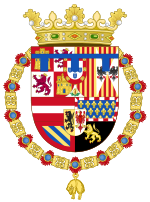
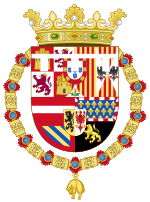
1608–1665 The eldest son of Philip III, Prince Philip (Philip IV as King of Spain and Philip III of Portugal), used the Royal Arms with label argent or azure. Philip's son, Prince Balthasar Charles also bore the same differences.[1][2][3] 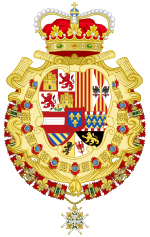
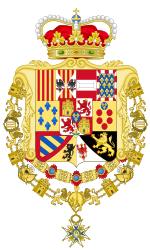
1707 -1761
1761 -1931The shields of the House of Bourbon's heirs apparent hardly ever depicted differences. Chronicler King of Arms Juan José Vilar y Psayla (1830–1894) said the arms of the Prince of Asturias were differentiated by a crown of four half-arches, the Spanish monarch's crown has eight half-arches since the reign of Philip V (1700–1746).[2] See also
References
- ^ a b c d e Francisco Olmos, José María de Las primeras acuñaciones del príncipe Felipe de España (1554-1556): Soberano de Milán Nápoles e Inglaterra. The First Coins of Prince Felipe of Spain (1554-1556): Sovereign of Milan, Naples and England. pp.165-166 (Spanish)
- ^ a b c d e f g Rodríguez de Maribona, Manuel Las armas del Príncipe de Asturias - ABC. (Spanish) Accessed 2009-05-28.
- ^ a b c d Menéndez-Pidal De Navascués, Faustino (2004). El Escudo de España. Madrid: Real Academia Matritense de Heráldica y Genealogía. pp. 191–192. ISBN 84-88833-02-4.
Coats of arms of Spain Autonomous communities Andalusia • Aragon • Asturias • Balearic Islands • Basque Country • Canary Islands • Cantabria • Castile-La Mancha • Castile and León • Catalonia • Extremadura • Galicia • Community of Madrid • Region de Murcia • Navarre • La Rioja • ValenciaAutonomous cities Royal Family The King • The Prince of AsturiasCategories:- Personal coats of arms
- Spanish coats of arms
- Spanish monarchy
- Princes of Asturias
Wikimedia Foundation. 2010.
